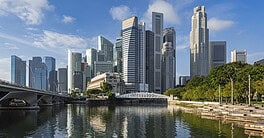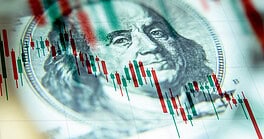Southeast Asian nations are benefiting from the return of global growth, with more room to grow capacity and exports—even as wages trend upward.
Exports are booming for many of the 10 members of the Association of Southeast Asian Nations (ASEAN). The bloc is now the sixth largest economy in the world, with a combined GDP of $2.8 trillion in 2017, according to Wood Mackenzie. ANZ Research forecasts GDP growth will average 5.3% this year, up from 4.9% in 2017. The risk of a slowdown in China has receded.

Yet it is not going to be smooth sailing. For one thing, many ASEAN economies are hampered by poor infrastructure, which drags on productivity gains. According to the Asian Development Bank, between 2018 and 2030 Southeast Asia needs to invest $3.15 trillion in infrastructure, roughly $242 billion a year. Even as countries, including Vietnam and the Philippines, invest in infrastructure, the moves follow years of underinvestment.
The specter of trade protectionism also looms large. The Comprehensive and Progressive Agreement for Trans-Pacific Partnership (CPTPP) is a workable alternative to the Trans-Pacific Partnership (TPP) following US withdrawal. But for Vietnam and Malaysia, CPTPP is second-best to TPP. “Their primary goal is to access the US market,” says Zhixing Zhang, East Asia analyst at geopolitical intelligence firm Stratfor. “US withdrawal means they have to reevaluate costs of many compromises they have to make, with diminishing gains.”
Nevertheless, demand is growing in the US, Europe and Japan, helping ASEAN exports become more diversified. For Europe, the IMF forecasts a 4.3% increase in global import volumes in 2018, after a 4.5% increase in 2017. If realized, that growth will mark the strongest phase of expansion in global trade since 2011. Major US companies like Boeing are bullish, with the aircraft manufacturer forecasting that Southeast Asia will require 4,210 new planes, valued at $645 billion, by 2036. Indeed, Boeing projects the region’s passenger traffic to accelerate by 6.2% in the next 20 years, 1.5% ahead of the world average.
Singapore and Malaysia remain Southeast Asia’s major tech exporters, but Indonesia and Thailand have also entered the fray. President Donald Trump’s fixation with the domestic economy is driving US business investment; and as US equipment spending has ticked upward in recent quarters, so have Asian exports, according to ANZ research.
Of course, the downside of dependence on big importers is clear. “Any acceleration in US inflation and wage pressures could result in the Fed stepping up the pace of monetary policy tightening,” says Rajiv Biswas, Asia-Pacific chief economist at IHS Markit. “This could create turbulence in Asian equity, bond and currency markets, risking capital outflows.”

Southeast Asia has some of the lowest labor costs in emerging markets—less than half China’s in some cases. As labor-intensive manufacturing quits China for cheaper locales, ASEAN is ready to absorb capacity. An early beneficiary is the Philippines, as depreciation of the peso renders it an attractive manufacturing destination. This may not last, as wages have been rising across the region in recent years—in 2016, typical monthly wages jumped 13.6% in Cambodia, for example, and more than 10% in Vietnam, Indonesia and Myanmar, according to the Japan External Trade Organization. Still, progress in AI/robotics means the prospect of labor-saving process automation is pervasive.
Trading Partners and Power
Southeast Asia, situated between huge economies to the north, east and west, has long been a trading powerhouse, familiar with adapting to shifting winds. In Singapore, the region’s bellwether export economy, GDP growth averaged 2% in 2015 and 2016—well below the 6% average of the highs and lows of the prior turbulent decade. Even so, Capital Economics forecasts GDP growth of 3% this year, after growing 3.6% in 2017, though cooling toward the end of the year. The global IT cycle driving demand may moderate this year, but strengthening global growth will likely offset any reduction in IT exports. Malaysia’s export volumes have been the region’s fastest growing, and GDP growth is expected to hit 5.5% this year, says Capital Economics. Volumes of outbound shipments grew more than 20% year-on-year at their peak last year, but that looks unsustainable in 2018
Vietnam’s GDP grew 6.8% in 2017—the fastest expansion since 2007—supported by breakneck growth in the manufacturing sector, which grew by 14.4%. Vietnam, among others, may benefit from the CPTPP, which could add 2% of GDP over the next decade, according to Capital Economics. Indonesia is working to improve the business environment: The World Economic Forum’s 2017–2018 Global Competitiveness Index listed Indonesia 36th out of 137 economies, up from 41st; and The World Bank 2017 Doing Business report ranked the country 72nd out of 190 economies.
To be sure, the good news is moderated by various forces, from trade treaties to exchange rates to market shifts. Thailand, for example, expects a record of over 37 million visitors to spend 3.1 trillion baht ($99 billion) this year, as tourists flock to its temples and azure waters. But the tourism boom has fueled rapid appreciation of the baht. In 2017, the Thai baht rose 10% against the US dollar, making it one of the best-performing emerging-market currencies. That is worrying policymakers and exporters. Still, there is little evidence of slowing demand—in 2017, exports from Thailand grew 10%, their quickest pace since 2011.
Politics impacts business, too. In Thailand, discontent with the ruling junta is growing after the postponement of November’s scheduled elections. And while Malaysia’s economy looks solid, with growth firing on all cylinders, political uncertainty lingers. In January, Bank Negara increased interest rates by 25bps to 3.25% amid signs of emerging inflationary pressures in the economy.
Southeast Asia can’t rely on exports forever, so nurturing diverse businesses and a robust domestic market are critical to long-term health. Brunei’s economy, for example, continues to rely almost entirely on its oil and gas resources, which account for 91% of exports, according to UNCTAD.
Although Indonesia’s domestic demand increased 5.2% year-on-year—the fastest in seven quarters—there seems limited upside, says ANZ Research. GDP is forecast to rise to 5.3% in 2018; and though exports remain buoyant, the stimulus to the domestic economy has been limited. Higher-frequency indicators, including motor vehicle sales, retail sales and bank lending, confirm tepid momentum in demand.
Malaysia developed a thriving Islamic-finance sector, known for innovation and strong regulation, and is now emerging as a major center for Islamic fintech. “Fintech should not be seen as a disrupter of traditional ways that is a threat,” Communications and Multimedia minister Datuk Seri Salleh Said Keruak said at the Malaysia Fintech Expo 2018, in early March. “Instead, fintech should be seen as a boost to the ecosystem.” He exhorted small and mid-sized companies to “embrace this digital phenomenon in the financial systems to embark towards greater heights.”
Still enjoying robust growth relative to the global average, Southeast Asia has always afforded opportunity to the forward-looking. The residential real estate market in Singapore, already one of the world’s richest countries, is currently down 35% from its 2013 peak. A recovery in exports is expected to benefit that moribund market.
Other opportunities beckon. The Vietnamese government, saddled with large public debt—estimated by the World Bank to hit 63.7% of GDP this year—is poised to sell off stakes in key industries, including power and energy. Cambodia, Laos and Myanmar look to be hotbeds for foreign direct investment in the power sector. With low power consumption per capita—between 300 and 1,800 kWh/person—the ongoing economic transformation is putting huge strains on already unreliable power supplies. The region’s lack of internal capital suggests governments may seek funding from international markets.



